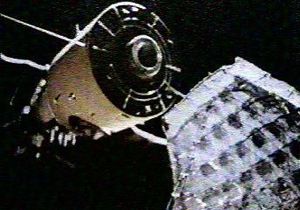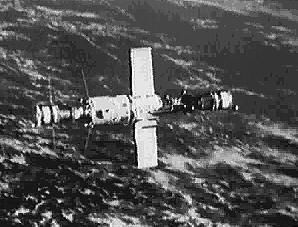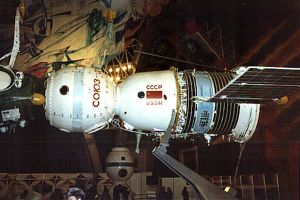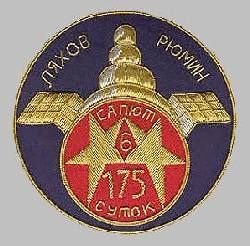
Home - Search - Browse - Alphabetic Index: 0- 1- 2- 3- 4- 5- 6- 7- 8- 9
A- B- C- D- E- F- G- H- I- J- K- L- M- N- O- P- Q- R- S- T- U- V- W- X- Y- Z
Soyuz 32
 Salyut 6 KRT-10 Salyut 6 KRT-10 deployment Credit: RKK Energia |
AKA: Proton (Proton);Salyut 6 EO-3;Soyuz 34. Launched: 1979-02-25. Returned: 1979-08-19. Number crew: 2 . Duration: 175.02 days.
Transported the EO-3 long-duration crew consisting of V A Lyakhov and V V Ryumin to the Salyut-6 space station to conduct scientific investigations and experiments and repair work.
Narrative (adapted from D S F Portree's Mir Hardware Heritage, NASA RP-1357, 1995)
The crew arrived aboard Salyut 6 on 26 February and put the station into operation and preparing it for repair of the propulsion system, which had sprung propellant leaks. After the arrival of Progress 5 on 14 March, propulsion system repairs began the next day. Fuel in the undamaged tanks was combined in one tank. The station was spun end over end so centrifugal force would separate UDMH fuel from the nitrogen pressurant leaked from behind the ruptured bellows in the damaged fuel tank. The fuel in the damaged tank was then pumped into the emptied good tank and into two tanks in Progress 5. The damaged tank was then sealed off and opened to space for 7 days.
On March 23 the tank was closed and filled with nitrogen pressurant, then vented again. This procedure was repeated several times in order to purge the tank of residual fuel traces. In addition, the 'supercharging line' was purged. On March 27 the damaged tank was purged once more, filled with nitrogen, then sealed off from the rest of the fuel system, leaving Salyut 6 with two functioning fuel tanks. The opening and closing of valves was carried out by the crew under supervision of the TsUP. According to Ryumin, the operation 'restored the entire system,' and 'the success of this operation enabled the station to fly several years beyond the end of the program.'
The EO-3 crew were to receive the international crew of Nikolai Rukavishnikov and Bulgarian Intercosmos cosmonaut Georgi Ivanov, on April 11. But Soyuz 33's main engine failed, forcing its return to Earth without docking with Salyut 6. This cast doubt on Soyuz 32's engine and the engines of other Soyuz Ferries. This in turn cast doubt on the EO-3 crew's ability to complete their mission - Soyuz 32 was nearing the end of its rated 90-day space endurance and needed to be replaced with a fresh craft. The Soyuz 33 crew returned safely to Earth on April 12 after a ballistic re-entry. It was decided to launch Soyuz 34 unmanned to replace Soyuz 32, which exceeded its 90-day stay limit on May 27.
First Progress 6 arrived on May 15. After unloading, Progress 6 circularized Salyut 6's orbit on May 29 in preparation for the arrival of Soyuz 34. It undocked on June 8, clearing the port for the arrival of Soyuz 34, which ensured that Ryumin and Lyakhov would be able to complete their mission. Soyuz 34 also tested improvements to the Soyuz main engine meant to prevent recurrence of the Soyuz 33 failure. The spacecraft delivered 200 kg of cargo. Soyuz 32 returned to Earth unmanned with a cargo of experiment results and malfunctioning Salyut 6 equipment. The equipment was of interest to space station engineers.
On 14 June the Soviets transferred Soyuz 34 from the aft port to the front port by rotating Salyut 6. This freed the aft port for Progress 7, which arrived on 30 June. Progress 7 delivered the 350-kg KRT-10 radio telescope. It comprised a total of seven pieces of equipment: antenna reflector, 'focal container and supports,' 'mechanism for securing the antenna to the station,' control console, 'time block,' and a package containing low frequency radiometers. The EO-3 crew assembled the antenna and its support equipment in the station and Progress 7's dry cargo compartment over a 2- week period.
Ryumin and Lyakhov had not seen the complete system before because the KRT-10 was still being tested and manufactured at the time they were trained to assemble it. Control panels were attached to the conical housing in the large-diameter compartment and data recorders to the station's 'ceiling.' A 'cable entrance mechanism' was assembled in the intermediate compartment, behind the device for securing the antenna to the station, which filled the aft port. The diameter of the folded antenna was only 0.5 m. As Progress 7 backed away from the station, Ryumin commanded the antenna to unfold from the aft port. A TV camera on Progress 7 transmitted a blurry image of Salyut 6's aft port to the TsUP and the TV aboard Salyut 6 as the KRT-10 opened to its full 10-m diameter.
On August 9 the KRT-10 antenna failed to separate from Salyut 6. Examination through the aft-facing ports indicated that the antenna was snared on the aft docking target. This prevented further Progress dockings and interfered with the engines. The EO-3 crew attempted to free the antenna by rocking the station. After considering abandoning Salyut 6 -- according to Ryumin, its primary mission was complete -- crew and TsUP agreed to attempt an EVA to remove the antenna.
Ryumin and Lyakhov performed the 83-min EVA on August 15. With difficulty Ryumin deployed a folded handrail, then clambered over the hull to the rear of the station. He found that the KRT-10's ribs had torn the station's insulation. As Ryumin cut cables the KRT-10 oscillated back and forth, threatening to strike him. Ryumin carried a 1.5-m barbed pole to push the antenna away after he finished cutting it away from Salyut 6. Once the antenna was discarded, the EO-3 crew inspected the exterior of Salyut 6. They found that portions of its insulation had broken off or become discolored. They also retrieved samples of materials that had been exposed to space conditions on Salyut 6's hull, and a portion of the micrometeoroid detector. After completing their mission, the crew returned safely in Soyuz 34.
More at: Soyuz 32.
Family: Manned spaceflight. People: Lyakhov, Ryumin. Spacecraft: Salyut 6.
 | Salyut 6 In Space Credit: RKK Energia |
 | Soyuz 7K-T Credit: © Mark Wade |
 | Salyut 6 EO-3 Credit: www.spacefacts.de |
1979 February 25 - . 11:53 GMT - . Launch Site: Baikonur. Launch Complex: Baikonur LC31. LV Family: R-7. Launch Vehicle: Soyuz-U.
- Soyuz 32 - . Call Sign: Proton (Proton ). Crew: Lyakhov, Ryumin. Backup Crew: Lebedev, Popov. Payload: Soyuz 7K-T s/n 48. Mass: 6,800 kg (14,900 lb). Nation: Russia. Agency: MOM. Program: Salyut 6. Class: Manned. Type: Manned spacecraft. Flight: Soyuz 32. Spacecraft Bus: Soyuz. Spacecraft: Soyuz 7K-T. Duration: 110.18 days. Decay Date: 1979-06-13 . USAF Sat Cat: 11281 . COSPAR: 1979-018A. Apogee: 256 km (159 mi). Perigee: 193 km (119 mi). Inclination: 51.60 deg. Period: 88.90 min. Manned two crew. Docked with Salyut 6. Transported a team consisting of V A Lyakhov and V V Ryumin to the Salyut-6 space station to conduct scientific investigations and experiments and repair work. Recovered June 15, 1979 16:18 GMT. Returned unmanned..
1979 March 12 - . 05:47 GMT - . Launch Site: Baikonur. Launch Complex: Baikonur LC31. LV Family: R-7. Launch Vehicle: Soyuz-U.
- Progress 5 - .
Payload: Progress s/n 104. Mass: 7,014 kg (15,463 lb). Nation: Russia.
Agency: MOM.
Program: Salyut 6.
Class: Manned.
Type: Manned logistics spacecraft. Flight: Soyuz 32.
Spacecraft Bus: Soyuz.
Spacecraft: Progress.
Duration: 23.77 days. Completed Operations Date: 1979-04-05 00:09:54 . Decay Date: 1979-04-05 00:09:54 . USAF Sat Cat: 11292 . COSPAR: 1979-022A. Apogee: 256 km (159 mi). Perigee: 183 km (113 mi). Inclination: 51.70 deg. Period: 88.80 min.
Unmanned supply vessel to Salyut 6. Delivery of fuel, consumable materials and equipment to the Salyut 6 station. Docked with Salyut 6 on 14 Mar 1979 07:19:21 GMT. Undocked on 3 Apr 1979 16:10:00 GMT. Destroyed in reentry on 5 Apr 1979 00:10:22 GMT. Total free-flight time 3.40 days. Total docked time 20.37 days.
1979 April 10 - . 17:34 GMT - . Launch Site: Baikonur. Launch Complex: Baikonur LC31. LV Family: R-7. Launch Vehicle: Soyuz-U.
- Soyuz 33 - . Call Sign: Saturn (Saturn ). Crew: Ivanov, Georgi, Rukavishnikov. Backup Crew: Aleksandrov, Aleksandr, Romanenko. Payload: Soyuz 7K-T s/n 49. Mass: 6,860 kg (15,120 lb). Nation: Russia. Agency: MOM. Program: Salyut 6. Class: Manned. Type: Manned spacecraft. Flight: Soyuz 32, Soyuz 33. Spacecraft Bus: Soyuz. Spacecraft: Soyuz 7K-T. Duration: 1.96 days. Decay Date: 1979-04-12 . USAF Sat Cat: 11324 . COSPAR: 1979-029A. Apogee: 261 km (162 mi). Perigee: 194 km (120 mi). Inclination: 51.60 deg. Period: 89.00 min. Manned two crew. Flight under the Intercosmos programme of an international team consisting of N N Rukavishnikov (USSR) and G I Ivanov (Bulgaria). Unsuccessful mission. Failed to rendezvous with Salyut 6..
1979 April 12 - .
- Landing of Soyuz 33 - . Return Crew: Ivanov, Georgi, Rukavishnikov. Nation: Russia. Related Persons: Ivanov, Georgi, Rukavishnikov. Program: Salyut 6. Flight: Soyuz 32, Soyuz 33. Soyuz 33 landed at 16:35 GMT. .
1979 May 13 - . 04:17 GMT - . Launch Site: Baikonur. Launch Complex: Baikonur LC31. LV Family: R-7. Launch Vehicle: Soyuz-U.
- Progress 6 - .
Payload: Progress s/n 106. Mass: 7,014 kg (15,463 lb). Nation: Russia.
Agency: MOM.
Program: Salyut 6.
Class: Manned.
Type: Manned logistics spacecraft. Flight: Soyuz 32.
Spacecraft Bus: Soyuz.
Spacecraft: Progress.
Duration: 27.61 days. Completed Operations Date: 1979-06-09 18:52:36 . Decay Date: 1979-06-09 18:52:36 . USAF Sat Cat: 11356 . COSPAR: 1979-039A. Apogee: 247 km (153 mi). Perigee: 190 km (110 mi). Inclination: 51.60 deg. Period: 88.80 min.
Unmanned supply vessel to Salyut 6. Delivery of fuel, consumable materials and equipment to the Salyut 6 station. Docked with Salyut 6 on 15 May 1979 06:19:22 GMT. Undocked on 8 Jun 1979 07:59:41 GMT. Destroyed in reentry on 9 Jun 1979 18:52:46 GMT. Total free-flight time 3.54 days. Total docked time 24.07 days.
1979 June 6 - . 18:12 GMT - . Launch Site: Baikonur. Launch Complex: Baikonur LC31. LV Family: R-7. Launch Vehicle: Soyuz-U.
- Soyuz 34 - .
Call Sign: Proton (Proton ). Payload: Soyuz 7K-T s/n 50. Mass: 6,800 kg (14,900 lb). Nation: Russia.
Agency: MOM.
Program: Salyut 6.
Class: Manned.
Type: Manned spacecraft. Flight: Soyuz 32.
Spacecraft Bus: Soyuz.
Spacecraft: Soyuz 7K-T.
Duration: 73.76 days. Decay Date: 1979-08-19 . USAF Sat Cat: 11387 . COSPAR: 1979-049A. Apogee: 254 km (157 mi). Perigee: 192 km (119 mi). Inclination: 51.60 deg. Period: 88.90 min.
Docked with Salyut 6. Launched unmanned to provide return vehicle for Soyuz 32 crew of Lyakhov/Ryumin after Soyuz 33 primary propulsion system failure. Checked the operation of the spacecraft propulsion unit; transportated the crew of the Salyut-6 station back to earth.
1979 June 15 - .
- Landing of Soyuz 32 - . Return Crew: Lyakhov, Ryumin. Nation: Russia. Related Persons: Lyakhov, Ryumin. Program: Salyut 6. Flight: Soyuz 32. Soyuz 32 landed at 16:18 GMT. .
1979 June 28 - . 09:25 GMT - . Launch Site: Baikonur. Launch Complex: Baikonur LC31. LV Family: R-7. Launch Vehicle: Soyuz-U.
- Progress 7 - .
Payload: Progress s/n 107. Mass: 7,014 kg (15,463 lb). Nation: Russia.
Agency: MOM.
Program: Salyut 6.
Class: Manned.
Type: Manned logistics spacecraft. Flight: Soyuz 32.
Spacecraft Bus: Soyuz.
Spacecraft: Progress.
Duration: 21.69 days. Completed Operations Date: 1979-07-20 01:57:19 . Decay Date: 1979-07-20 01:57:19 . USAF Sat Cat: 11421 . COSPAR: 1979-059A. Apogee: 251 km (155 mi). Perigee: 186 km (115 mi). Inclination: 51.60 deg. Period: 88.80 min.
Unmanned supply vessel to Salyut 6. Delivery of fuel, consumable materials and equipment to the Salyut 6 station. Docked with Salyut 6 on 30 Jun 1979 11:18:22 GMT. Undocked on 18 Jul 1979 03:49:55 GMT. Destroyed in reentry on 20 Jul 1979 01:57:30 GMT. Total free-flight time 4.0 days. Total docked time 17.69 days.
- KRT-10 - . Payload: KRT-10. Nation: Russia. Agency: MOM. Program: Salyut 6. Flight: Soyuz 32. Spacecraft: KRT-10. Decay Date: 1979-08-26 . USAF Sat Cat: 11493 . COSPAR: 1977-097BD. Apogee: 385 km (239 mi). Perigee: 359 km (223 mi). Inclination: 51.60 deg. Period: 91.99 min. 10 m diameter radio telescope. Attached to Salyut 6 docking hatch and deployed after separation of Progress from Mir..
1979 August 15 - . 14:16 GMT - .
- EVA Salyut 6 EO-3-1 - . Crew: Lyakhov, Ryumin. EVA Duration: 0.0576 days. Nation: Russia. Related Persons: Lyakhov, Ryumin. Program: Salyut 6. Class: Manned. Type: Manned space station. Flight: Soyuz 32. Spacecraft Bus: Almaz. Spacecraft: Salyut 6. Jettisoned KRT-10 antenna from rear docking port..
1979 August 19 - .
- Landing of Soyuz 34 - . Return Crew: Lyakhov, Ryumin. Nation: Russia. Related Persons: Lyakhov, Ryumin. Program: Salyut 6. Flight: Soyuz 32. Soyuz 34 landed at 12:30 GMT with the crew of Lyakhov and Ryumin aboard..
Back to top of page
Home - Search - Browse - Alphabetic Index: 0- 1- 2- 3- 4- 5- 6- 7- 8- 9
A- B- C- D- E- F- G- H- I- J- K- L- M- N- O- P- Q- R- S- T- U- V- W- X- Y- Z
© 1997-2019 Mark Wade - Contact
© / Conditions for Use